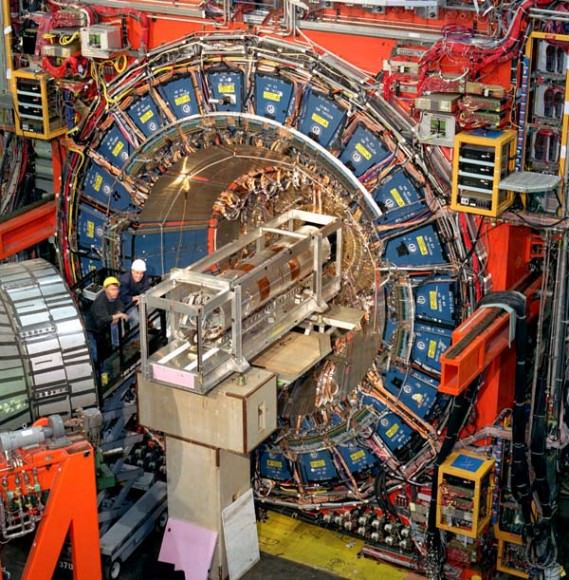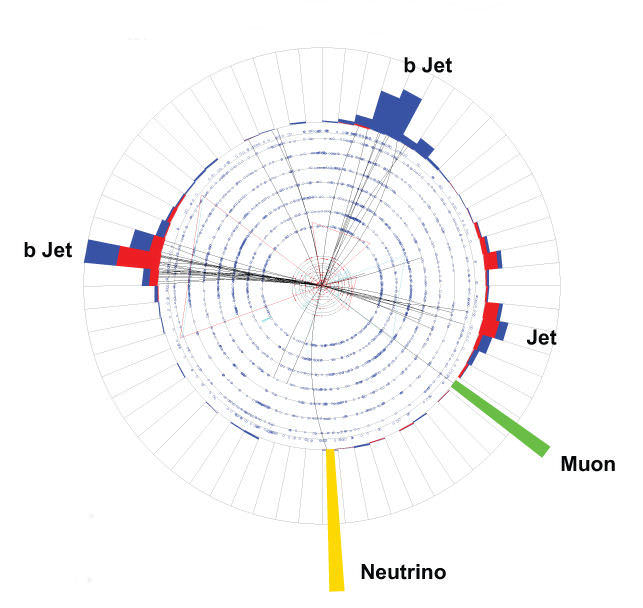[/caption]
Scientists at Fermilab have observed particle collisions that produce single top quarks, a 1 in 20 billion find. This discovery confirms important parameters of particle physics, including the total number of quarks. Previously, top quarks had only been observed when produced by the strong nuclear force. That interaction leads to the production of pairs of top quarks. The production of single top quarks involves the weak nuclear force and is harder to identify experimentally. This observation occurred almost 14 years to the day of the top quark discovery in 1995.
Fermilab’s Tevatron, located near Chicago, Illinois is currently the world’s most powerful operating particle accelerator, and the discovery was made by scientists working on together on collaborations. Scientists say finding single top quarks has significance for the ongoing search for the Higgs particle.

“Observation of the single top quark production is an important milestone for the Tevatron program,” said Dr. Dennis Kovar, Associate Director of the Office of Science for High Energy Physics at the U.S. Department of Energy. “Furthermore, the highly sensitive and successful analysis is an important step in the search for the Higgs.”
Searching for single-top production makes finding a needle in a haystack look easy. Only one in every 20 billion proton-antiproton collisions produces a single top quark. Even worse, the signal of these rare occurrences is easily mimicked by other “background” processes that occur at much higher rates.
Discovering the single top quark production presents challenges similar to the Higgs boson search in the need to extract an extremely small signal from a very large background. Advanced analysis techniques pioneered for the single top discovery are now in use for the Higgs boson search. In addition, the single top and the Higgs signals have backgrounds in common, and the single top is itself a background for the Higgs particle.
To make the single-top discovery, physicists of the CDF and DZero collaborations spent years combing independently through the results of proton-antiproton collisions recorded by their experiments, respectively.
CDF is an international experiment of 635 physicists from 63 institutions in 15 countries. DZero is an international experiment conducted by 600 physicists from 90 institutions in 18 countries.

Each team identified several thousand collision events that looked the way experimenters expect single top events to appear. Sophisticated statistical analysis and detailed background modeling showed that a few hundred collision events produced the real thing. On March 4, the two teams submitted their independent results to Physical Review Letters.
The two collaborations earlier had reported preliminary results on the search for the single top. Since then, experimenters have more than doubled the amount of data analyzed and sharpened selection and analysis techniques, making the discovery possible. For each experiment, the probability that background events have faked the signal is now only one in nearly four million, allowing both collaborations to claim a bona fide discovery that paves the way to more discoveries.
“I am thrilled that CDF and DZero achieved this goal,” said Fermilab Director Pier Oddone. “The two collaborations have been searching for this rare process for the last fifteen years, starting before the discovery of the top quark in 1995. Investigating these subatomic processes in more detail may open a window onto physics phenomena beyond the Standard Model.”
Source: Fermilab


“For each experiment, the probability that background events have faked the signal is now only one in nearly four million”
but
“Only one in every 20 billion proton-antiproton collisions produces a single top quark.”
Ouh!
So does that mean for every real top quark found there are 5,000 fake ones?
I thought colour confinement prevented free quarks from existing.
@dollhopf: I’d say the 20 billion collision figure is already included in the probability calculation..
A very impressive feat for Fermilab. Congrats to them! Considering all of the awesome work Fermilab has done with Tevatron, the future looks blazingly bright for CERN and the LHC. We’re coming for you Higgs…
Wait, I thought it was impossible for quarks to exist without being color neutral (either a RGB triplet, or a Color-antiColor pair).
How can you have a lone quark without having a net color? Does this rule not apply to the more massive quarks?
Hmm . . . observing a ‘one in 20 billion’ odds event is interesting. Is it possible there may be some misinterpretation?
I suspect the writing is a bit sloppy, and that they mean that normally a pair of top-quarks are produced (1 top 1 anti-top), but that in this case the other quark is of some other flavor.
Because had it been a single quark production, that violates color confinement, i would have expected it to be headlines on every single newspaper…
Alas, Excalibur ,I suspect you are right. As one old enough to remember the gleefull headlines of a few years ago announcing the viewing of ‘bare bottom’ after a similar discovery, I can only lament that this latest unpared quark was not in fact an antiquark. Imagine the headlines then ‘TOPLESS MESON DISCOVERED!!! Who says science isn’t fun?
To: Excalibur, If this event was observed several hundred times; doesn’t that suggest the odds are not one in twenty billion.
They did observe the ‘one in 20 billion’ event a few 100 times though, after removing what they considered uncertain identifications…
Maybe they analyzed 2 trillion collisions?
😛
if an event that is “one in 20 billion” is observed several hundred times, they did a total of some maybe 10 trillion measurements (it doesnt say the exact number of observations so the total is uncertain)… simple math
The top quark is in a meson that is color neutral. One example is where the top is bound with a d-bar quark, which decays to a u quark plus a b-bar. This decay is mediated by the W^- electroweak vector. Another weak mediated process is (t,b) –> (ud), again mediated by W^-. The production of the top quark may occur with a gluon, which results in a b and b-bar. The bottom b may be converted to a t with the occurrence of the W^+.
Of course these events are all inferred from the production of secondary particles. These channel productions are cxomputed and triggered on. The 1 in 4 million means that the event expected is sufficiently well catelogued so that the CDF track finding program will have a 1 in 4 million chance of getting it wrong. So this is a pretty good confidence level.
Lawrence B. Crowell
I am very suspicious of this figure of 1 in 4 million.
If you know the frequency with which an event occurs, the probability of getting a false positive and a false negative it is a relatively easy exercise in basic statistics (Bayes theorem) to work out the chance that something labelled ‘the event’ is actually it!
For the figure of 1 in 4 million to be true the chances of false positives and negatives would have to be effectively zero!
The secondary decay products will come with discrete energy for a given direction detected. These track finding procedures are pretty well defined, and the error estimates controlled. I admit that 1:4million seems a bit extreme, but I am not privy to the phenomenology (which is considerable) that went behind this.
Lawrence B. Crowell